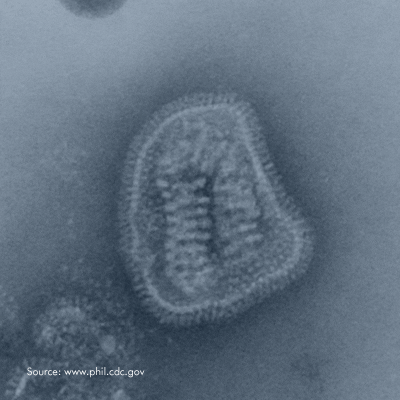| Virus | Influenza B |
| Structure | Enveloped |
| Genome | Single stranded RNA, negative sense |
| Family | Orthomyxoviridae |
| Primary Host | Humans |
| Disease(s) Caused | Influenza |
| Symptoms | Fever, runny nose, sore throat, muscle aches, lethargy |
| Potential Complications | Pneumonia, worsened heart conditions |
| Transmission Mode | Direct contact with infected mucus, inhalation of aerosols, contact with contaminated fomites |
| Sites of Community Outbreaks | Schools, hospitals, workplaces |
Importance of Influenza B Virus
The Influenza B virus is an enveloped member of the Orthomyxoviridae family. Influenza B, along with Influenza A, is responsible for the respiratory illness influenza (flu).
Influenza B differs from influenza A in that influenza B only infects humans and seals, while influenza A infects a wide range of animals, including birds and pigs. This increased host range allows influenza A to mutate about 2-3 times faster than influenza B. Influenza B is still able to mutate fast enough to prevent lasting immunity, making prevention and regular vaccination essential.
Symptoms of influenza B match those of influenza A but tend to be a little less severe. Most people recover within a few days to two weeks, but complications, such as pneumonia, can occur. Because there is no non-human reservoir for influenza B, pandemics are unlikely to arise.
Importance of Disinfection: Survival of Influenza B on Surfaces and Potential for Transmission via Fomites
Influenza B is transmitted primarily through large, airborne droplets. Indirect transmission through contaminated surfaces is also possible. Self-infection can potentially occur when someone touches a contaminated surface and then transfers the virus to a mucous membrane, such as the epidermal lining of the nose or mouth.
Influenza B is enveloped and is therefore sensitive to inactivation by environmental factors. It can remain infectious for 1-2 days on nonporous surfaces like stainless steel. Because of its enveloped structure, influenza B is highly susceptible to a range of chemical disinfectants. Disinfectants that are effective against other enveloped viruses, including influenza A, may be effective against influenza B.
An influenza B strain is included in the yearly flu vaccine, but the actual circulating strain can vary. This means that vaccinated individuals can still develop influenza if they are infected with a different strain.
References
- Bean, B., et al. “Survival of influenza viruses on environmental surfaces.”Journal of Infectious Diseases 146.1 (1982): 47-51.
- Nobusawa, Eri, and Katsuhiko Sato. “Comparison of the Mutation Rates of Human Influenza A and B Viruses.” Journal of Virology 80.7 (2006): 3675–3678. PMC. Web. 20 Jan. 2016.
- Zambon, Maria C. “Epidemiology and pathogenesis of influenza.” Journal of Antimicrobial Chemotherapy 44.suppl 2 (1999): 3-9.

